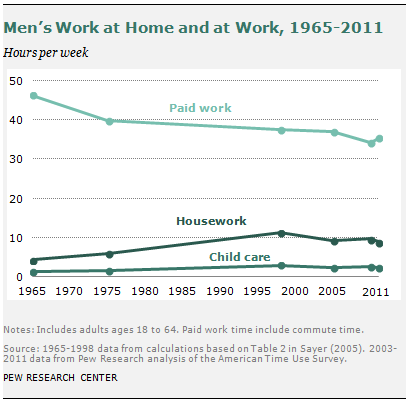X
Xantippe
Guest
Right. There’s all sorts of social science on this:Also, there are plenty of studies showing that women still do the majority of the housework, even when working outside the home. There’s “no more women’s work”? Where? Even when couples try to make things fair, it’s just never going to be 100% fair. Households don’t work that way.

Chapter 5: Americans’ Time at Paid Work, Housework, Child Care, 1965 to 2011
One of the most significant changes in American society in the past half century is women’s increasing presence in the workplace. In 1965, 42% of women
 www.pewresearch.org
www.pewresearch.org
" In 1965, working-age men (ages 18 to 64) on average spent 46 hours per week at paid work; by 2011, the number had fallen to about 35 hours per week. Working-age women doubled their time at paid work, from 15 hours per week in 1965 to 30 hours per week in 1998; the amount has gone down somewhat in the recent decade, to 25 hours per week in 2011.
“On the home front, men are spending more time doing housework than they did in the 1960s, while women have cut back their hours in this area. Men’s housework time has doubled from four hours per week in 1965 to about nine hours per week in 2011. Women, meanwhile, have cut their housework time almost in half, from about 28 hours per week to 15 hours per week during the same period.”
“Child care time for men has increased over time, from one hour per week to about two hours. For women, the average time spent taking care of children has been relatively stable, ranging from five to six hours per week. Because not all men or women have children, the average child care time for all is much lower than it is for parents.”
If you look at the chart for “women’s work at home and at work” you’ll notice that time devoted to paid work is way up, time devoted to housework is way down, and time devoted to childcare is pretty consistent over the last 50 years.
" Married mothers with young children are the major driving force for the rise of women’s employment rate. In 1968, about 37% of working-age married women with young children were employed; in 2011, it was about 65%.
“Despite the trend of more mothers working for pay, American parents’ time with children continues to go up. Fathers have nearly tripled the time they spend with their children (from 2.5 hours in 1965 to 7.3 hours today). After a slight decline in the 1970s and ’80s, mothers’ time with children has also increased, and today’s mothers spend more time with their children than mothers did in the 1960s.”
“The time married mothers devoted to child care increased from 10.6 hours per week in 1965 to 14.3 hours per week in 2011, and married fathers’ time spent on child care increased from 2.6 hours to 7.2 hours during the same period.”
